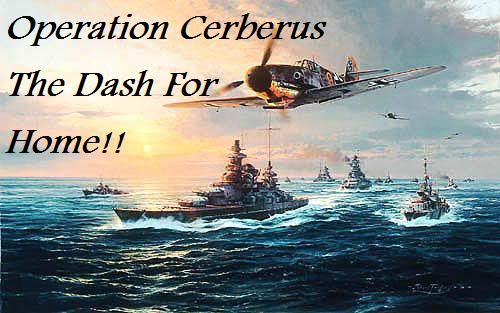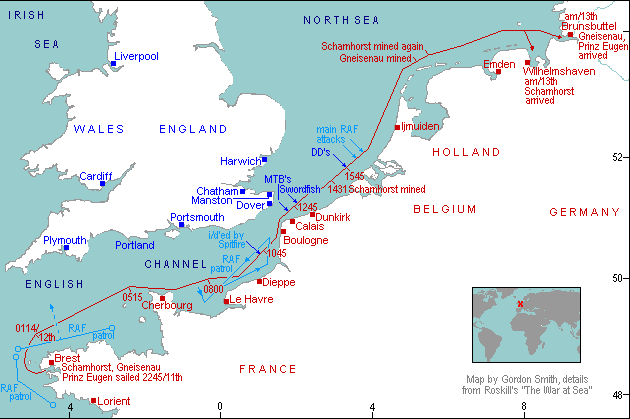

This week's setup is brought to us by 1LtCAP, and features some unusual twists:
FEBRUARY 11-13, 1942
The Channel Dash (see map above and
history below)
AXIS (Knights)
Bf-109F (carrier and land based)
FW-190A5 (land based only)
Bf-110C4 (land based only)
Ju-87 (carrier and land based)
Ju-88 (land based only)
PT (E-boat sub)
ALLIES (Bishops)
Spitfire V
F4F Martlet
TBM (torpedo and guns only)
PT (MTB sub)
SPECIAL NOTES:
Both sides are limited to coastal base use.
Carriers are not player-commanded.
Carriers have no mannable 5", no puffy ack.
Carrier light ack is .25 (one-fourth MA standard).
Southwest winds, gradually shifting west with altitude.
Use Channel 200 for cross-country,
Channel 123 for side-only communications.
Fog is set at 6 miles.
Traditional AvA bombsight (must be calibrated).
Radar settings as follows:
Tower 105,600 (feet)
Sector 237,600
Fuel is 1.0 burn rate.
Friendly mid-airs are off.
Killshooter is on.
HISTORY:
The Brest Squadron (Vice-Adm Ciliax) with "Scharnhorst",
"Gneisenau" and "Prinz Eugen", heavily escorted by air and
other naval forces, left late on the 11th for Germany in
Operation 'Cerberus'. The aim was to pass through the Strait
of Dover around noon the next day. A number of problems
conspired to prevent the RAF standing patrols detecting their
departure. The first intimation of the breakout came with a
RAF report around 10.45 on the 12th as the German force
steamed towards Boulogne. This left little time for attacks
to be mounted. Soon after midday the first was made by five
motor torpedo boats from Dover and six Swordfish torpedo-
bombers of 825 Squadron (Lt-Cdr Esmonde), but no hits
were made. All Swordfish were shot down. Lt-Cdr Eugene
Esmonde was posthumously awarded the Victoria Cross.
From then on, events moved swiftly. At 14.30 off the Scheldt,
"Scharnhorst" was slightly damaged by a mine. An hour later,
torpedo attacks by six destroyers from Harwich were
unsuccessful. Twenty minutes later a heavy attack by the
RAF failed. The German ships carried on and in the early
evening off the Dutch Frisian Islands, first "Gneisenau" and
then "Scharnhorst" (for the second time) hit mines. Both
were damaged, but together with "Prinz Eugen" reached
German ports in the early hours of the 13th. The escape
was an embarrassment for the British Government, but a
tactical victory for the German Navy was also a strategic
gain for the Royal Navy. The Brest Squadron no longer
directly threatened the Atlantic convoy routes, both battle
cruisers were damaged and ten days later "Prinz Eugen" was
badly damaged. Two weeks later "Gneisenau" was damaged
even more in a RAF raid on Kiel and never went to sea again.
A start was made on repair but in early 1943 she was laid up.